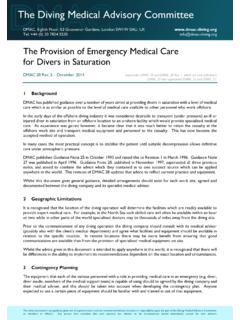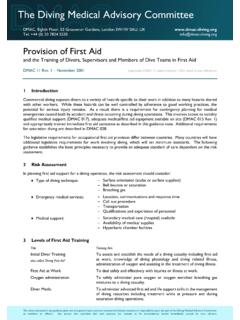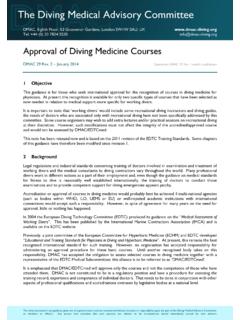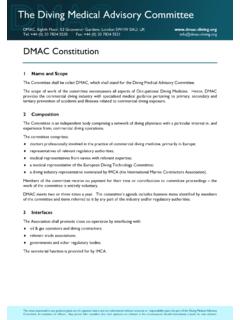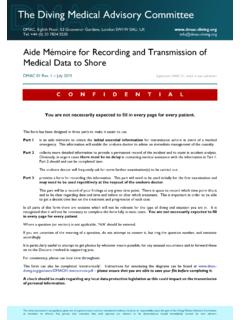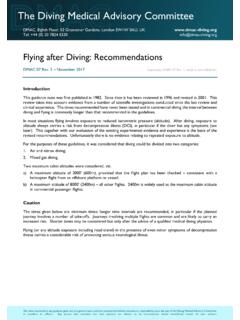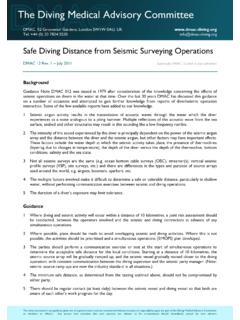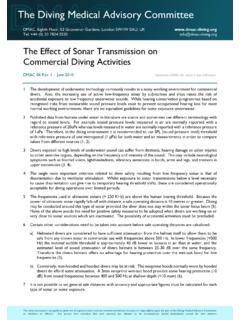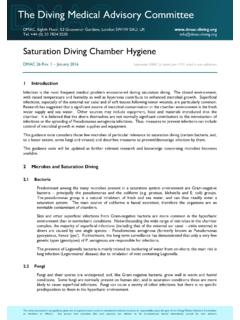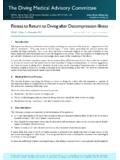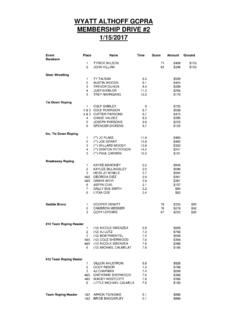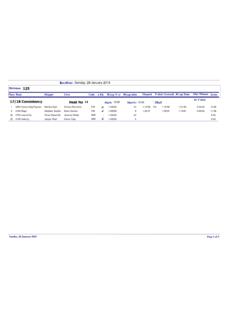Transcription of The Diving Medical Advisory Committee
1 The Diving Medical Advisory Committee DMAC, Eighth Floor, 52 Grosvenor Gardens, London SW1W 0AU, UK Tel: +44 (0) 20 7824 5520 The views expressed in any guidance given are of a general nature and are volunteered without recourse or responsibility upon the part of the Diving Medical Advisory Committee , its members or officers. Any person who considers that such opinions are relevant to his circumstances should immediately consult his own advisers. Medical Equipment to be Held at the Site of an Offshore Diving Operation DMAC 15 Rev. 4 December 2014 Supersedes DMAC 15, DMAC 15 Rev. 1, Rev. 2 and Rev. 3, which are now withdrawn Commercial Diving operations include both surface supplied and saturation Diving operations and cover a wide range of work activities. Appropriate Medical equipment to be held at any particular site is best determined by an occupational health service with special knowledge of commercial Diving operations.
2 This list is designed to provide guidance on equipment to be held at the site where such advice is not available. It is recognised that in certain circumstances similar or greater facilities may be available from other sources which are sufficiently close and reliable. The list covers equipment and drugs suitable for the treatment of Diving related disorders on the surface or in a recompression chamber and for other potential problems ( trauma) which may occur during Diving operations. The list takes account of situations where the Diving operation may be remote from a vessel or installation sickbay and Medical services. It includes equipment for use in an immediate first aid situation, equipment and drugs which may be used by personnel with advanced first aid training as well as equipment which would almost certainly only be used by Medical staff.
3 Medical staff who attend a casualty at a dive site may not necessarily be able to bring the appropriate equipment. Each Diving contractor s Diving Medical Officer is responsible for a review of the equipment and drugs, as some of the drugs mentioned in this note may not be available in some geographical areas and in such cases alternative drugs to those identified and suggested should be considered. Compliance with the local laws relating to pharmaceutical products will also have to be considered, as these vary in different countries. It is anticipated that except in emergency situations, equipment other than that in the bell or chamber first aid kits would be for use by or on the direction of Medical staff. There should be an appropriate system for the control and maintenance of this Medical kit and responsibility for this kit should be vested in the Diving Superintendent or vessel Medic.
4 The respective responsibilities and authority of the parties involved need to be clearly documented and understood. This kit should be accompanied by a list of contents. This list provides an opportunity for stock control, shelf life control, and the recording of the use of the contents. These measures should be regarded as standard procedure. A specific logbook should be maintained with the equipment, in which these checks and all use of equipment and drugs is recorded. The Diving supervisor needs to have access to this Medical kit at all times. Scheduled or controlled drugs should be held in a dedicated and secure double locked container (with the vessel s Medical supplies or in the installation sickbay). The Medical kit should be appropriately labelled and then inspected regularly (during each mobilisation and at least every six months) to ensure that all items are in working order ( batteries) and to exchange drugs and other equipment which is nearing the end of its shelf life.
5 These regular inspections should be recorded in the logbook. Consideration should be given to the need for pressure testing mechanical or electrical equipment. Local conditions may require a more frequent inspection regime. People involved in the provision of care in Diving situations should be part of a system of continuous training to help prevent skill fade. At all times, including during transit to the Diving worksite or Diving support vessel, this Medical kit must be kept dry and clean, locked in an appropriately labelled and dedicated light-resistant container. Care must be also taken to ensure that this equipment is stored within a temperature range of +4 to +25 Celsius. Page 2 December 2014 DMAC 15 Rev. 4 The kit should be packaged and labelled in a logical manner that allows easy and rapid access to the contents, specifically those contents that are often used at the same time.
6 This is a guidance document based on current information. This Medical kit will not cover all the aspects of Medical care in a Diving system and should be used in conjunction with the installation or vessel s Medical kit. There should thus always be good communication between the Diving team and the vessel medic. Audits of any DMAC 15 kits should involve Medical staff (doctor or ship s Medic) with experience in the field, who understand the limitations of this guidance note, understand the Diving project and the potential difficulties of the procurement of certain drugs depending on the county jurisdiction where the Diving is taking place. A copy of DMAC 15 should accompany each kit with the final page completed as appropriate. DMAC 15 Rev. 4 December 2014 Page 3 Equipment to be Held in a Diving Bell, Hyperbaric Welding Habitat or immediately available to be put into a Diving Chamber (to be stored in a watertight bag or container).
7 1 Arterial tourniquet ( CAT tourniquet) 3 Polythene bags these can be used to cover burns or as waste bags 1 Resuscitation face mask (preferably with a silicone filled face seal and a non-return valve) or shield, for mouth-to-mouth ventilation ( Laerdal pocket mask or face shield) 2 Oropharyngeal airways size 3 and 4 ( Guedel type) 1 Tuff cut scissors 1 Medium dressing 1 Large dressing 2 Triangular bandages 1 Roll of 1 inch adhesive tape 2 Crepe bandages 3 inch 1 Hand operated suction pump 1 Suction catheter (preferably Yankeur) 1 Watertight bag 1 Adult adjustable cervical spine collar 2 Pairs of non-sterile gloves (non-latex if possible, appropriately sized) 2 Space blankets The same equipment should be available for rapid use in each living chamber of a saturation system and in each air Diving chamber. In living chambers a foot or gas powered suction pump may be preferred.
8 The watertight bag is not required within dry living chambers and it is acceptable that this equipment may be stored outside the system ready to be passed in immediately, as required. Equipment to be Held in a Hyperbaric Rescue Unit (HRU) Compartment (or within the surface compartment of a self propelled hyperbaric lifeboat): 1 Arterial tourniquet ( CAT tourniquet) 3 Polythene bags 1 Resuscitation face mask (preferably with a silicone filled face seal and a non-return valve) or shield, for mouth-to-mouth ventilation ( Laerdal pocket mask or face shield) 2 Oropharyngeal airways size 3 and 4 ( Guedel type) 1 Tuff cut scissors 1 Medium dressing 1 Large dressing 2 Triangular bandages 1 Roll of 1 inch adhesive tape 2 Crepe bandages 3 inch 1 Hand operated suction pump 1 Watertight bag 1 Suction catheter (preferably Yankeur) 1 Adult adjustable cervical spine collar 10 pairs of non-sterile gloves (non-latex if possible, appropriately sized) Sealable vomit and metabolic waste bags must be provided that allow for safe containment and disposal of this waste.
9 Suggested: Absorbeze Maxi Sick Bags. Consideration should be given to the number of occupants and possible time expected before retrieval. A minimum of 15 per occupant is required. Given the confines of the evacuation unit and the potential for contamination, anti-diarrhoeal preparations such as Imodium should be considered. Fluid replacement supplies which can be primarily water, to allow approx 100-150mls per man per hour, must be available. Rehydration preparations to maintain electrolytic balance should also be considered as essential to augment the fluid balance of both the dive and surface crew. Page 4 December 2014 DMAC 15 Rev. 4 In the event of the requirement for hyperbaric evacuation, the following need to be available for immediate passing into the chamber prior to the divers entering the HRU. The surface support crew also need to be given the same medication: Each team member (both divers and surface support crew) should chew 2 x 300 g tablets of hyoscine hydrobromide and have a Scopolamine patch placed behind one ear prior to evacuation into an HRU.
10 The 2 hyoscine hydrobromide tablets will take effect within 30mins and last approximately 7-8 hours, after which the dermal patches will become effective and last approximately 72 hours. The number of tablets and patches required depends on the number of people within both the dive team and surface support team, and will need to be calculated prior to each mobilisation. There should be extra tablets and patches available for the dive and support team in case of failure of the adhesiveness of the dermal patches. Equipment to be Held at the Dive Site: Diagnostic Equipment 1 Pencil torch 1 Thermometer (electronic) 1 Low range rectal thermometer down to 28 C 1 Stethoscope 1 Aneroid sphygmomanometer 1 Reflex hammer 1 Tape measure 2 Tuning forks (128Hz and 256Hz) Pins for testing sensation ( Neurotips) Blood sugar testing equipment Tongue depressors Urine testing strips 1 Otoscope (with spare bulb and batteries and disposable ear pieces) Thoracocentesis 2 Intercostal drain and drainage kits preferably those without sharp metal trocar introducers ( Portex flexible introducer type) 4 Devices for emergency needle thoracocentesis 2 Heimlich Valves Suitable strapping/fixing to secure the system appropriately Urinary Catheterisation 2 Urinary catheters (preferably non-latex) sizes 16 and 18 ( Foley type) 2 Urine collection bags 2 Catheter spigots (optional)
